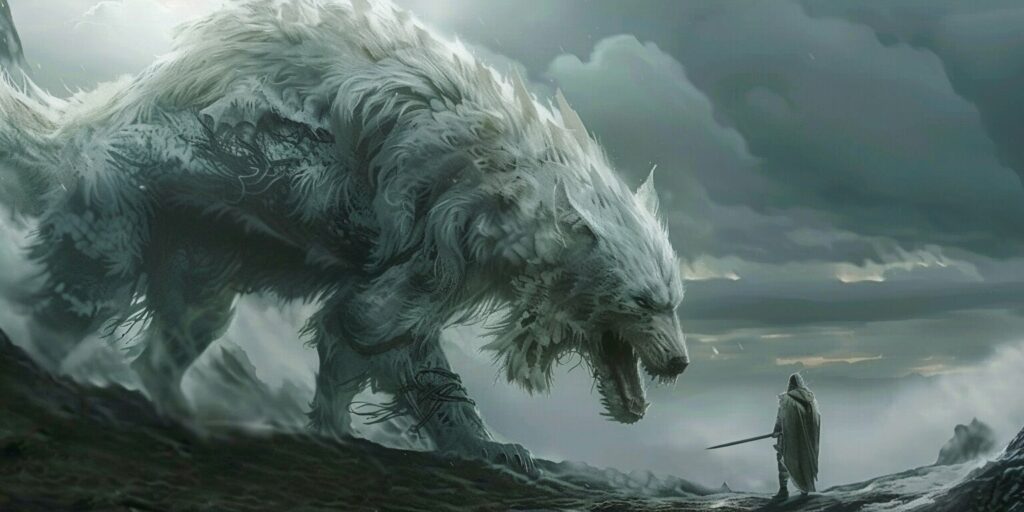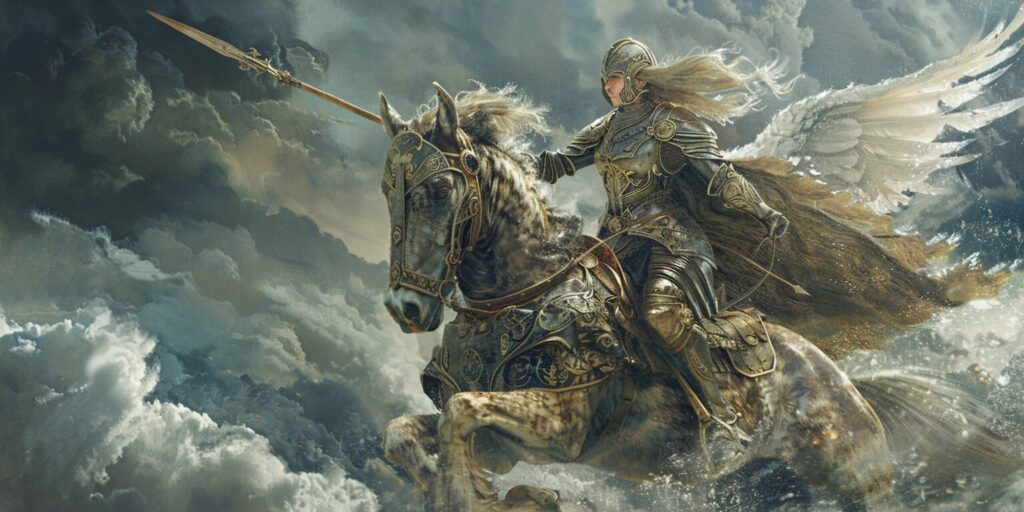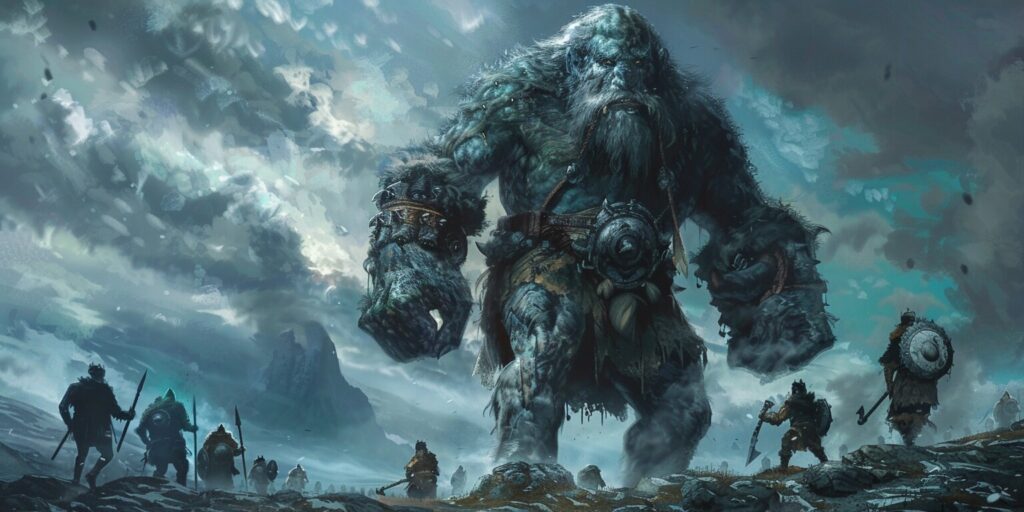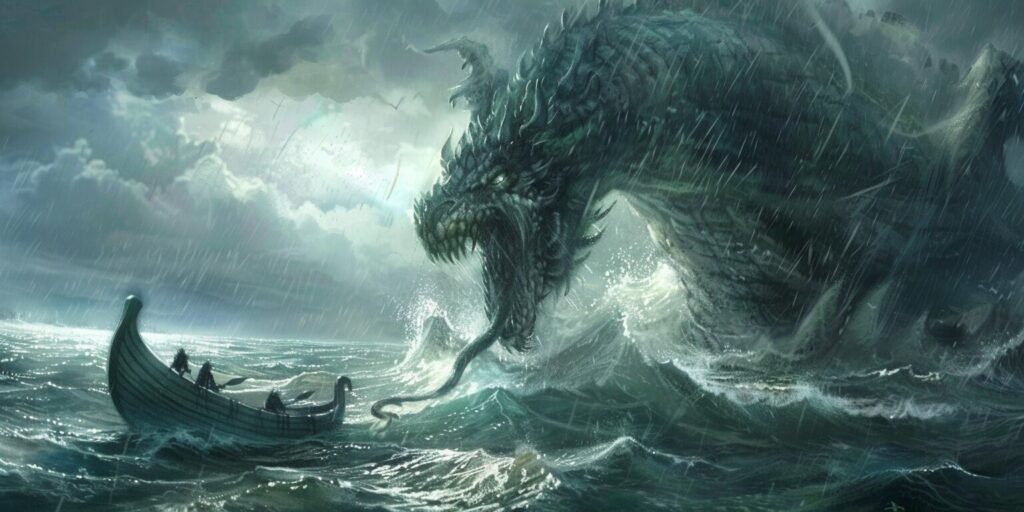Creatures in Norse mythology, Dwarves, Fenrir, Giants (Jötunn), Norse Mythology, Sleipnir, Tales of the Gods, Valkyries
Fearsome and Fantastic: The Most Terrifying Creatures in Norse Mythology
Norse mythology, a rich tapestry of myths and folklore originating in the ancient Scandinavian and Germanic regions, offers a host of mythical creatures with unique stories and significance. This mythology, woven into the very fabric of Norse culture, features beings ranging from the majestic to the monstrous, playing crucial roles in the cosmos and in the fates of gods and humans alike. Keep reading this article to delve deeper into the top 10 Norse mythology creatures.
The Mysterious Dwarfs of Norse Mythology
Origins and Role of Dwarfs in Norse Mythology
In the depths of the Norse cosmos, specifically within the realms of Svartalfheim, dwell the dwarfs, central to Norse myth and folklore. These creatures, emerging from the primordial being Ymir, are not only master smiths but also custodians of magical secrets. Their creation stories are deeply entwined with the Norse creation myth, depicting them as beings magically powerful, often mistaken for the dark elves due to their profound connection with the earth and status as Norse mythology creatures.
Unique Abilities and Traits of Dwarfs
Dwarfs in Norse mythology are renowned for their craftsmanship and supernatural abilities. They are depicted as able to swim through solid rock and forge magical items like Thor’s hammer, Mjolnir, demonstrating the prowess of beings and creatures. These beings are magically powerful and capable of turning the tide in the battles of gods with their enchanted creations, showcasing the significant role of beings and magical creatures in Norse mythology.
Interactions with Other Mythical Beings
The dwarfs interact frequently with other creatures and gods within Norse myths. Their dealings with Odin and Thor are particularly noteworthy, supplying these gods with powerful artifacts that play pivotal roles in mythic narratives. Through these interactions, the dwarfs influence events across the Nine Worlds of Norse mythology, from Midgard to Asgard.
The Mighty Fenrir: The Dreaded Wolf
The Story of Fenrir’s Binding
Fenrir, the giant wolf, is one of the most formidable creatures in Norse mythology. Born of Loki and the giantess Angrboda, Fenrir grows so large and powerful that the gods, fearing his strength, decide to bind him, highlighting the complex relationships among Norse gods, beings, and creatures. This event, fraught with deceit and foreboding, uses magical fetters crafted by Norse creatures like dwarfs, highlighting the creatures’ crucial role in the tales of gods and mythical beings.

Fenrir’s Prophesied Role in Ragnarok
Fenrir’s most significant role is during Ragnarok, the end of the world in Norse myth, showcasing the dire consequences of the gods’ interactions with jötnar. He is prophesied to break free from his chains and wreak havoc across the realms, including slaying Odin, the All-Father. This apocalyptic narrative places Fenrir at the center of Norse eschatological myth, symbolizing chaos and destruction.
The Majestic Sleipnir: Odin’s Eight-Legged Steed
Origin and Symbolism of Sleipnir
Sleipnir, the eight-legged horse of Odin, stands out in Norse mythology not just for his unique physical attributes but also for his symbolic meanings. Born of Loki, who transformed into a mare, and the mighty stallion Svadilfari, Sleipnir represents superhuman strength and the capability to travel across the Nine Worlds, embodying the connection between different realms.
Sleipnir’s Adventures in Norse Mythology
Sleipnir’s tales are woven throughout the sagas, where he serves as Odin’s steed. His adventures include galloping across Yggdrasil, the World Tree, and playing a critical role during significant events like the Aesir-Vanir War, and quests highlighting Norse mythology creatures’ involvement. Sleipnir’s abilities make him an emblem of the interconnected nature of the Nine Worlds.
Connection to Odin and the Nine Realms
Sleipnir’s relationship with Odin highlights themes of loyalty, power, and the mystical elements typical of Norse mythology creatures. As Odin’s horse, Sleipnir is central to many of Odin’s journeys and quests in old Norse mythology, symbolizing the god’s far-reaching power and wisdom. This connection underscores the thematic depth of old Norse mythology, where creatures and gods reflect broader cosmic and moral orders.
The Valkyries: Choosers of the Slain
Role and Purpose of Valkyries in Norse Mythology
Valkyries, known as the ‘choosers of the slain,’ are formidable figures in Norse mythology. Serving Odin, these maidens select those who may die and those who may live in battles. Their choices are essential to the afterlife in Valhalla, where the slain warriors are taken to prepare for Ragnarok. This role highlights the Valkyries’ influence over war and fate in old Norse stories, embodying themes of destiny and heroism in Norse tales.

Depictions of Valkyries in Norse Art and Literature
In art and literature, Valkyries are depicted as elegant maidens, often riding on horseback, equipped with helmets and spears. This portrayal reflects their martial nature and status as iconic symbols of bravery and valor in the face of inevitable death, resonating deeply with the Viking ethos of courage and strength.
The Enigmatic Kraken: The Sea Monster of Norse Lore
Legends and Stories Surrounding the Kraken
The Kraken, a fearsome sea monster in Norse mythology, is said to be so large that he was able to encircle the entirety of Midgard and grasp his own tail. Often mistaken for an island, the Kraken emerges from the depths to attack ships and is a potent symbol of the unpredictable power of the sea.
Interactions between Kraken and Seafarers
Seafarers’ tales of encounters with the Kraken include dramatic battles and narrow escapes, highlighting the interaction between humans and the forces of nature within Norse myth. These stories, filled with the stench of decay and the sounds of the forest-like appendages of the Kraken, emphasize the creature’s link to the primal fear of the unknown.
Symbolism and Meaning of the Kraken in Norse Culture
In Norse culture, the Kraken represents the perils of the ocean and the boundaries of the known world. Often considered the most terrifying creature in Norse mythology, it embodies the mysteries beyond the edges of the map, reminding those who venture too far of the dangers that await them.
Ratatoskr: The Mischievous Squirrel Messenger
Ratatoskr’s Role in Connecting the Worlds
Ratatoskr, the squirrel of Yggdrasil, serves a unique function within Norse mythology. He acts as a messenger among the Norse gods and creatures. Scampering up and down the World Tree, he carries messages between the eagle perched at the top and the serpent Nidhogg gnawing at the roots. This role keeps the tree’s denizens informed and illustrates the interconnectedness of all life within the Nine Worlds.
Relationship Between Ratatoskr and Other Creatures
Ratatoskr’s interactions with other creatures of Yggdrasil reflect the dynamics of Norse mythological themes. His role in sustaining the enmity between the eagle and Nidhogg by spreading gossip and tales underscores the perpetual conflict and balance within the Norse cosmos, mirroring the ongoing struggles between order and chaos.
Jotnar: The Giants of Norse Mythology
Types and Varieties of Jotnar in Norse Mythology
The Jotnar, or giants, are fundamental to Norse mythology. They embody natural forces and often oppose the Aesir gods, making them key figures among Norse mythology creatures. From frost giants like Ymir to fire giants like Surtr, their variety reflects the elemental diversity of the Norse cosmos. These beings, from the icy realm of Jotunheim, play crucial roles in the myths, challenging the gods and instigating key events like Ragnarok.

Encounters Between Jotnar and Gods
The encounters between the Jotnar and the gods, such as Thor and Loki, are marked by conflict and trickery. These interactions, fraught with challenges and battles, serve as metaphors for the struggles between different aspects of nature and the divine, highlighting themes of power, cunning, and destiny in Norse mythology.
Conclusion
The creatures of Norse mythology, from the industrious dwarfs to the mighty Fenrir, the majestic Sleipnir to the terrifying Kraken, and the mischievous Ratatoskr to the formidable Jotnar, illustrate a world vibrant with mythical beings, each contributing to the rich fabric of Norse myth and folklore. These stories passed down through generations, continue to fascinate and inspire, capturing the imagination with tales of power, conflict, and harmony in the ancient Norse world, featuring a myriad of Norse gods and creatures.

